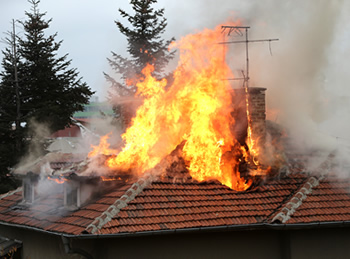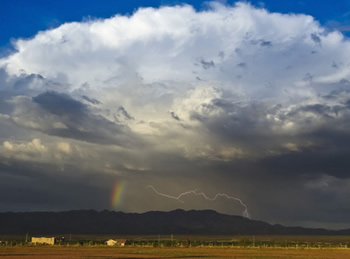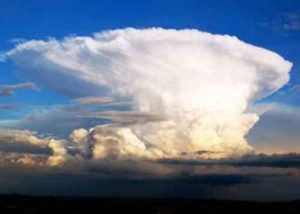Formation of a storm cloud
The presence of unstable, humid and warm air masses results in the formation of storm clouds: cumulonimbus clouds.
This type of cloud is very developed, both horizontally (around 10 km in diameter) and vertically (up to 15 km). Its very characteristic shape is often compared to the profile of an anvil, of which it has horizontal lower and upper planes. The existence in a cumulonimbus of very significant temperature gradients (the temperature can drop to – 65°C in the upper part), leads to very rapid ascending air currents; this results in an electrification of the water particles.
In a typical thundercloud, the upper part, made of ice crystals, is generally positively charged, while the lower part, made of water droplets, is negatively charged. By influence, the lower part of the cloud leads to the development of charges of opposite signs (therefore positive on the part of the ground which is nearby).
Electrical exchanges occur inside this cloud, but also between different clouds of the same nature. We then see lightning.
However, the cumulonimbus also behaves like a gigantic cloud-to-ground plane capacitor, whose intermediate distance often reaches 1 to 2 km.
The electro-atmospheric field on the ground, which is of the order of a hundred volts per meter (in good weather), is then reversed and can reach an absolute value of 15 to 20 kV/m when a discharge to the ground is imminent. .
This discharge when it occurs is called lightning strike.


Formation of a lightning strike
Observation without specific equipment does not make it possible to discern the phases of the formation of a lightning strike.
However, the following phenomena occur in most lightning strikes:
- A bright descending tracer starts from a point in the cloud and advances about 50 m at a speed of 50,000 km/s.
- A second descending tracer starts from the same point, follows the previous path with a comparable speed, passes the stopping point of the first by a similar distance and disappears in turn.
The process is repeated in this way until the head of the last tracer arrives a few dozen meters from the ground.
As soon as the head of a descending tracer approaches the ground, a cloud-ground connection is established with the electrostatic effluvia (corona effect) from the ground. An ascending tracer from the ground to the cloud then occurs: this is the priming phenomenon.
Note: The “magnitude” of the initiation is inversely linked to the distance from the storm cloud. This is why a tall building will be more “easily” hit by lightning.
The meeting of the two phenomena (descending and ascending tracer) constitutes the main discharge (lightning strike), which can be followed by a series of secondary discharges traveling through the channel ionized by the main discharge of a single tracer.
In an average negative lightning strike, the current intensity value is close to 25,000 amperes.

The characteristic phases of the evolution of negative lightning strike:
1. Descent of the tracer by leaps.
2. Initiation of ascending tracers.
3. Meeting between an ascending tracer and the descending tracer by leaps, then flow of the arc current in return.

